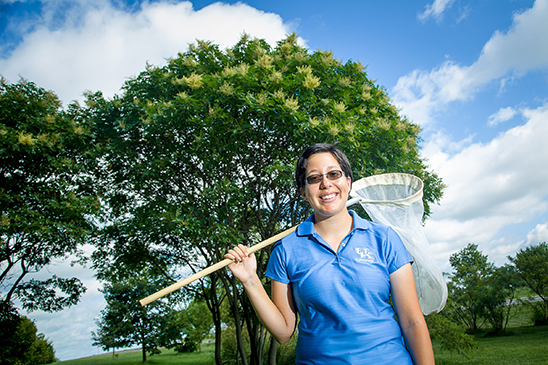UK research reveals list of bee-friendly plants
UK research reveals list of bee-friendly plants

A University of Kentucky entomology student has developed a list of bee-friendly trees and shrubs for the Ohio Valley region. The list can help homeowners, who have a desire to participate in bee conservation efforts, find the right plants for their yards.
“This list allows the average homeowner to participate in meaningful bee conservation efforts using science-based plant recommendations,” said Bernadette Mach, a doctoral student in the UK College of Agriculture, Food and Environment who is working with Professor Daniel Potter’s program.
In the past five to 10 years, researchers estimate that pollinator populations have declined between 30 and 60 percent, depending on the pollinator. While much of the attention has focused on dwindling honeybee populations due to colony collapse disorder, native bee populations including bumblebees, mason bees and many other solitary bee species, are also on the decline. Habitat loss due to urban and suburban sprawl is one of the main reasons.
Mach, originally from Hartselle, Alabama, started her research project in the summer of 2014. It is the first comprehensive study of its kind. The project has been supported by grants from the Bayer North American Bee Care Center, the Horticultural Research Institute, U.S. Department of Agriculture’s National Institute of Food and Agriculture, and UK’s Office of the Vice President for Research.
“This research provides a way to help restore the habitat and resources of bees and other pollinators while diversifying urban landscapes with horticulturally desirable plants,” Potter said.
Mach took visual counts of bees visiting various trees and shrubs in locations around Lexington and Cincinnati, two urban centers relatively close in distance with comparable landscape plantings. She also identified 50 bees visiting the plant or planting at each site. She would repeat this for a particular plant species at five different sites, characterizing both the relative attractiveness of about 75 different species of woody landscape plants, as well as the types of bees that visit each plant across a total of about 375 different landscape sites.
“We wanted to document which species of bees visit which species of woody ornamentals,” Mach said. “This information is useful for distinguishing which plants a honeybee keeper might want to plant versus someone who is interested in conserving bumblebees.”
The list includes bee-friendly ratings of plants along with the bloom times of each. Mach identified a number of horticulturally desirable but underutilized plants as “bee magnets,” information that could help to spur sales of those plants by Kentucky nursery producers, landscapers, and garden centers. The full list of bee-friendly trees and shrubs titled, “Plants Bees Like Best,” is available at http://growwise.org/ChallengeToolkit/. It is also available on the Potter lab website https://entomology.ca.uky.edu/files/bee_friendly_shrubs_and_trees_handout.pdf.
Entomology Extension Horticulture Research


